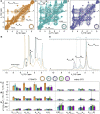Fast Magic-Angle-Spinning NMR Reveals the Evasive Hepatitis B Virus Capsid C-Terminal Domain
- PMID: 35653505
- PMCID: PMC9400876
- DOI: 10.1002/anie.202201083
Fast Magic-Angle-Spinning NMR Reveals the Evasive Hepatitis B Virus Capsid C-Terminal Domain
Abstract
Experimentally determined protein structures often feature missing domains. One example is the C-terminal domain (CTD) of the hepatitis B virus capsid protein, a functionally central part of this assembly, crucial in regulating nucleic-acid interactions, cellular trafficking, nuclear import, particle assembly and maturation. However, its structure remained elusive to all current techniques, including NMR. Here we show that the recently developed proton-detected fast magic-angle-spinning solid-state NMR at >100 kHz MAS allows one to detect this domain and unveil its structural and dynamic behavior. We describe the experimental framework used and compare the domain's behavior in different capsid states. The developed approaches extend solid-state NMR observations to residues characterized by large-amplitude motion on the microsecond timescale, and shall allow one to shed light on other flexible protein domains still lacking their structural and dynamic characterization.
Keywords: Dynamics; Hepatitis B Virus; Relaxation; Solid-State NMR; Viral Capsid.
© 2022 The Authors. Angewandte Chemie International Edition published by Wiley-VCH GmbH.
Conflict of interest statement
The authors declare no conflict of interest.
Figures





References
-
- Mittermaier A. K., Kay L. E., Trends Biochem. Sci. 2009, 34, 601–611. - PubMed
-
- Siemer A., Arnold A., Ritter C., Westfeld T., Ernst M., Riek R., Meier B. H., J. Am. Chem. Soc. 2006, 128, 13224–13228. - PubMed
-
- Cousin S. F., Kadeřávek P., Haddou B., Charlier C., Marquardsen T., Tyburn J.-M., Bovier P.-A., Engelke F., Maas W., Bodenhausen G., Pelupessy P., Ferrage F., Angew. Chem. Int. Ed. 2016, 55, 9886–9889; - PubMed
- Angew. Chem. 2016, 128, 10040–10043.
Publication types
MeSH terms
Substances
LinkOut - more resources
Full Text Sources

